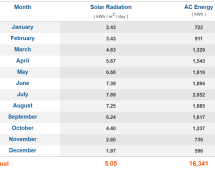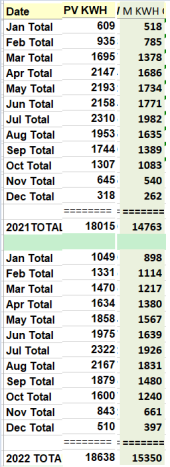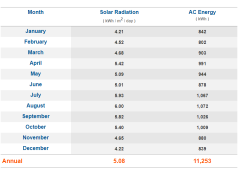voland
New Member
Good day,
This is my first post so please forgive the wall of text…
Im primarily looking for validation of my assumptions and some opinions if I am not thinking about this correctly. Keep in mind that I am fairly new to this and I will be doing a lot of reading and watching youtube for information to gain better understanding of these systems.
Background and data Ive gathered so far
Im building a new house in a very rural part of Texas and I am not 100% sure how reliable the power situation is going to be. My goal is to have a solar system that can run a large portion of the house during the day to offset my electric usage, under optimal conditions. Additionally, I would like to have enough battery capacity to heat/cool a bit of space for 3 days, in case of an emergency/power down type situation. Assuming some sunny days, I would like to have this system run pretty reliably "indefinitely". By that, I mean as long as the battery life cycle will permit. Yes, the pessimist in me wants to have a plan B…
Under normal conditions, my current and fairly inefficient house, used 7.2 kWh during the highest use hour of the highest use day which used a total of 129.8 kWh for the day. I expect this house to do a lot better since it will be better insulated, have more efficient HVAC systems (likely heatpump) etc. Nevertheless, I am basing my calculations on this…
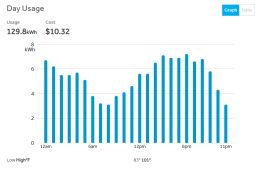
The house plans allow for roughly 22 panels to be deploy with a south/south-east exposure(~150 degrees).
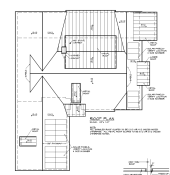
Using 400w panels, I should be able to achieve a peak ~8800w give or take a few. I can see about getting higher producing panels but lets use this for the sake of my calculation… I would like to have some extra panels in the garage that I could add in case of a prolonged grid down scenario to augment the system so I would get larger inverters than needed to handle the extra panels. Eventually, I will have an electric car, so I would like to wire up the charger to allow to backfeed from the cars battery too.
Below are my estimated loads I got using a simple load calculator and Im not sure how accurate are the ratings for the devices…
This is what I would consider to be a high running load that I could see during the day. Looks like my max load would be approximately 5.2kWh
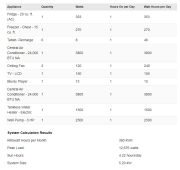
This is what I would expect to run during a grid down scenario where I would have to rely on battery power to provide coverage after "dark". Looks like I would be using approximately 4.7kWh per night.
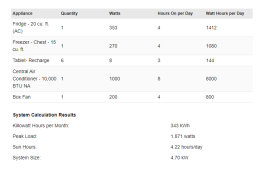
Based on these assumptions, here's the system that I am proposing…
22 400w panels on roof
8 400w panels on ground (if needed)
12 kWh inverter
14 32 kWh battery bank
charge controller (not sure what kind yet)
My "off grid" loads would be wired to a critical loads panel that would be energized by the battery bank
Optional 14kw propane generator on a 1000 gallon tank to charge up/run the house to help run the house while the propane lasts?
Questions:
1 - Am I even close to on target or am I talking nonsense?
2 - I was going to use a high efficiency 12000 btu heat pump for my heating cooling needs. I was thinking of doing a dedicated ductless system just for the master bedroom which is the room Ill want to keep heated/cooled. Would it be better to use a ducted system and heat/cool the bathroom as well? Should I look at other options?
3 - Fridges and Freezers don’t really run 24x7. They cycle. Does the kWH rating means its running non stop? Should I be using a % of that load for my calculations?
4 - What should I reasonably expect to generate from a 400w panel on a 12-12 slope facing south/south-east on a sunny day?
5 - If you read to this point, and you had similar requirements, would you do anything differently?
Thank you in advance for everyone's time and comments!
This is my first post so please forgive the wall of text…
Im primarily looking for validation of my assumptions and some opinions if I am not thinking about this correctly. Keep in mind that I am fairly new to this and I will be doing a lot of reading and watching youtube for information to gain better understanding of these systems.
Background and data Ive gathered so far
Im building a new house in a very rural part of Texas and I am not 100% sure how reliable the power situation is going to be. My goal is to have a solar system that can run a large portion of the house during the day to offset my electric usage, under optimal conditions. Additionally, I would like to have enough battery capacity to heat/cool a bit of space for 3 days, in case of an emergency/power down type situation. Assuming some sunny days, I would like to have this system run pretty reliably "indefinitely". By that, I mean as long as the battery life cycle will permit. Yes, the pessimist in me wants to have a plan B…
Under normal conditions, my current and fairly inefficient house, used 7.2 kWh during the highest use hour of the highest use day which used a total of 129.8 kWh for the day. I expect this house to do a lot better since it will be better insulated, have more efficient HVAC systems (likely heatpump) etc. Nevertheless, I am basing my calculations on this…

The house plans allow for roughly 22 panels to be deploy with a south/south-east exposure(~150 degrees).

Using 400w panels, I should be able to achieve a peak ~8800w give or take a few. I can see about getting higher producing panels but lets use this for the sake of my calculation… I would like to have some extra panels in the garage that I could add in case of a prolonged grid down scenario to augment the system so I would get larger inverters than needed to handle the extra panels. Eventually, I will have an electric car, so I would like to wire up the charger to allow to backfeed from the cars battery too.
Below are my estimated loads I got using a simple load calculator and Im not sure how accurate are the ratings for the devices…
This is what I would consider to be a high running load that I could see during the day. Looks like my max load would be approximately 5.2kWh

This is what I would expect to run during a grid down scenario where I would have to rely on battery power to provide coverage after "dark". Looks like I would be using approximately 4.7kWh per night.

Based on these assumptions, here's the system that I am proposing…
22 400w panels on roof
8 400w panels on ground (if needed)
12 kWh inverter
charge controller (not sure what kind yet)
My "off grid" loads would be wired to a critical loads panel that would be energized by the battery bank
Optional 14kw propane generator on a 1000 gallon tank to charge up/run the house to help run the house while the propane lasts?
Questions:
1 - Am I even close to on target or am I talking nonsense?
2 - I was going to use a high efficiency 12000 btu heat pump for my heating cooling needs. I was thinking of doing a dedicated ductless system just for the master bedroom which is the room Ill want to keep heated/cooled. Would it be better to use a ducted system and heat/cool the bathroom as well? Should I look at other options?
3 - Fridges and Freezers don’t really run 24x7. They cycle. Does the kWH rating means its running non stop? Should I be using a % of that load for my calculations?
4 - What should I reasonably expect to generate from a 400w panel on a 12-12 slope facing south/south-east on a sunny day?
5 - If you read to this point, and you had similar requirements, would you do anything differently?
Thank you in advance for everyone's time and comments!
Last edited:



